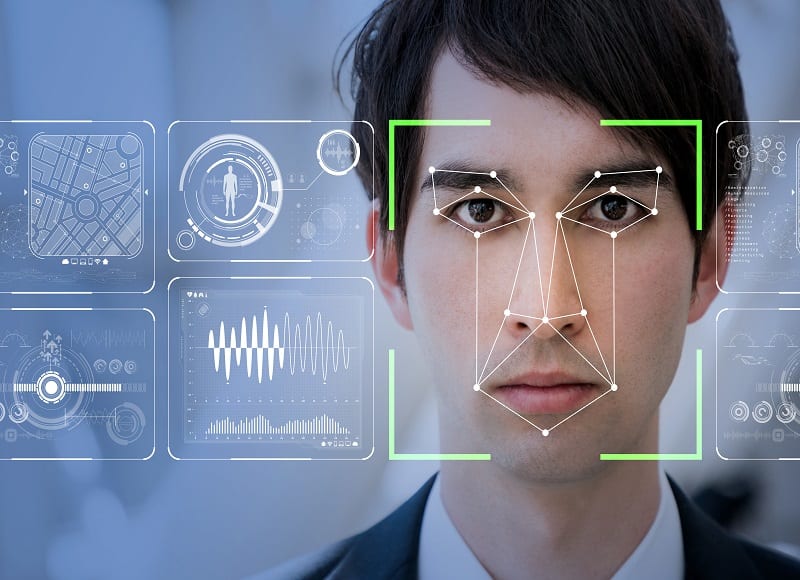As artificial intelligence-driven facial recognition systems blur the lines between privacy and security and can culminate in a surveillance state, is this the future that we want to build?
Introduction
As artificial intelligence brings nations high-speed facial recognition capabilities, surveillance societies are rising across nations: blurring the lines between privacy and security.
This is due to the enormous scale of changes that are enabled by significant advancements in technology: digital imaging, high-speed processing, skin texture analysis, thermal cameras, machine learning, 3D sensors, speech recognition, mood recognition, and more. These advancements break technical barriers allowing the extensive collection, recording, storage, analysis, and application of digital data and information.
Moreover, the explosion in processing power allows powerful computers utilizing artificial intelligence and machine learning to execute facial recognition capabilities with almost perfect accuracy. Today, facial recognition technology can be used to identify not only individuals but also uncover additional personally identifiable information (PII), such as photos, blog posts, social networking profiles, and internet behavior all through facial features alone. This is just the tip of the iceberg. As a result, concerns are understandably growing over which entities and persons have authorized access to this information.
Across nations, we see shifting paradigms between privacy and security, and at present, nearly everything that happens in our individual and collective lives — what we speak, do, and perhaps think shortly — can be recorded and stored indefinitely. This reality doesn’t just apply to our electronic and internet presence — the newest frontier of surveillance aims to document the abstract, including emotions, mood, and soon perhaps thoughts as well. As a result, privacy and security are mostly becoming an illusion today and so is the boundary between private and public places.
As these monumental changes are underway, the growing adoption of facial recognition technology brings society both risks and rewards. While this technology has the power to uncover terrorist networks and disrupt obfuscated threats to society, it has also been used by oppressive regimes and opportunistic corporations to quiet opposition voices and withholds power. It is this dual-use nature of facial recognition technology that necessitates a greater understanding of this capability, the promise and perils surrounding it, and its broader impact across nations: its governments, industries, organizations, and academia (NGIOA). This exploration is fundamental to understanding future technological developments, both the risks and rewards that prepare us to face the future.
This brings us to an important question: Since there is no clear delineation of what data is being collected about us, often without consent, or where and when it is being used, who is responsible for the breach of privacy and the security risks each one of us is vulnerable to?
Facial Recognition Technology
As research advances in facial recognition technology, it affords nations the ability to create groups using distinct attributes and efficiently eliminate different faces from system consideration. Since this system can now identify gender and racial markers, skin color, and much more, coupled with advancements in processing power and artificial intelligence technology, today’s facial recognition systems present great rewards and risks to you and me.
A complex facial recognition system is made of diverse technology: cameras, sensors, video, processing capabilities, skin texture analysis, thermal cameras, algorithms, and technology capable of identifying and verifying a person from a digital image or a video frame. While there are multiple ways in which facial recognition systems execute these searches, in general, they work by comparing selected facial features from a given image to faces in a digital database (private or public). In short, facial recognition software works by matching real-time imaging to any available image of the said individual.
As a result of these advancements, facial recognition technology has become very powerful and lucrative. From national security entities to surveillance states, social media companies to law enforcement agencies, the application of intelligent, high-speed facial recognition systems is boundless. It is the growing use, democratization, and commercialization of this technology that fundamentally changes the dynamics of day-to-day privacy and security for citizens of the world.
Surveillance and Security
Although facial recognition technology has been traditionally associated with the surveillance and security sector, the active expansion of technology over the past few years has introduced surveillance systems into different parts of society. As a result, it fundamentally changes the way we operate and interact with each other and with entities across NGIOA.
As mentioned, the use of facial recognition technology is widespread, and the potential applications are endless. Today, these systems can be found in smartphones, social media websites, smart devices, drones, autonomous vehicles, and more. The use of facial recognition systems is deployed across vulnerable entry and exit points like airports, trains, and bus stations to identify potential security threats, enabling intelligent real-time detection of any emerging security threats. Moreover, this is just the beginning- That brings us to an important question: do we understand the totality of risks emerging from the widespread use of facial recognition technology.
Acknowledging this emerging paradigm, Risk Group initiated a much-needed discussion on Artificial Intelligence Powered Facial Recognition Technology with Brenda Leong, CIPP/US, Senior Counsel and Director of Strategy with Future of Privacy Forum on Risk Roundup.
Disclosure: Risk Group LLC is my company
Risk Group discusses Artificial Intelligence Powered Facial Recognition Technology with Brenda Leong, CIPP/US, Senior Counsel and Director of Strategy with Future of Privacy Forum based in the United States.
Complex Challenges and Risks
As the applications of facial recognition, technology expands beyond national security organizations and law enforcement agencies, the privacy and security risk questions affect each one of us. There is also a growing concern that emerging facial recognition technology could compromise our identity. The reason behind that is an AI-driven facial recognition system database can potentially define our literal and social mobility. As seen in China, individual identification is increasingly tied to controversial social and ethnic classification and ranking— thereby determining access and privileges. That brings us to an important question: are citizens of nations going to be comfortable with algorithms determining and defining our social status and rights?
Across nations, facial recognition systems are defined for a specific purpose. While there are benefits in its applications, a troubling reality exists when an automated system is utilized without accountability. What are the ethical questions surrounding surveillance technology? It seems the ethical issues around facial recognition systems are ones of democratization, liability, privacy, security, and exploited social hierarchies. This is deeply concerning because these records and determinations do not go away — they are permanent and will always be part of an individual’s digital identity. That brings us to an important question: how do we combat the rise of the social ranking?
Moreover, since facial recognition technology is designed to operate at a distance, it is often a permissionless system. Meaning, this monitoring, and surveillance happen without the knowledge or consent of its targets: you and me. So, as facial recognition technology targets broadly, there are understandable concerns raised over privacy and security. However, this discussion rises above privacy and security and becomes one of the individual and human rights. That brings us to an important question: is the definition of individual rights changing?
Some believe that a surveillance society directly undermines individual rights, with the technology holders/controllers having unprecedented access into an individual’s life. That brings us to an important question: do we have a right to anonymity?
Future of Facial Recognition System
Amid the growing implementation, adoption, and acceptance of facial recognition technology, where is this AI-driven surveillance system taking society? What is the power of the evolving facial recognition system? What does it mean for the future of humanity?
Are surveillance corporations on the rise? Are surveillance states on the rise? It seems like China is already on its way in establishing a universal video surveillance network to track individuals and groups of interest. What are the implications of monitoring foreign nationals in a surveillance state? Where will this lead? Which other countries are planning to adopt a similar approach and goals? Irrespective of the component of a nation or nation, the very ability to track individuals, their associations, and beliefs give rise to more questions and concerns than answers. Also, when nations begin to assign a single social credit score and ranking on trustworthiness to their citizens, it is a cause of great concern on many fronts.
The Emerging Surveillance Society
As it seems, AI-driven facial recognition systems are enabling the formation of surveillance societies. As a result, the concern is that as the surveillance power of facial recognition technology becomes ubiquitous: and gets embedded within systems, structures, and the stakeholders they represent, its growing applications are perhaps being ignored or taken for granted and consequences are probably going unnoticed. Moreover, considering the data-in-transit makes national boundaries irrelevant, the impact of real-time surveillance becomes more challenging to regulate. That brings us to an important question: If we are re-defining and re-designing a society that relies on surveillance to monitor and thwart threats, what is in store for the future of humanity?
What Next?
As facial recognition technology rapidly advances and moves towards commercialization, concerns over privacy and intent move to the forefront. While the development in facial recognition technology is remarkable, there is a consequential need to question the motive and understand and evaluate its impact on the social fabric: on diversity, discrimination, race, religion, trust, accountability, transparency, privacy, access to services, mobility, freedom, community, social justice and security. It is fundamental that this growing power is exercised reasonably, responsibly, and following human rights, civil liberties, and the rule of law. It is time each one of us individually and collectively evaluates: Is this the society that we want to build for our coming tomorrow.
NEVER MISS ANY OF JAYSHREE’S POST
Just join here for a weekly update from Jayshree





 Hacking Our Identity: The Emerging Threats from Biometric Technology
Hacking Our Identity: The Emerging Threats from Biometric Technology